A Literature Review on Psychosocial Management of Diabetes Patients
VerifiedAdded on 2023/04/26
|23
|6889
|52
Literature Review
AI Summary
This literature review paper explores, evaluates, and analyzes existing literature on psychosocial management of the emotions of diabetic patients. It begins by highlighting diabetes mellitus as a global public health problem affecting millions, emphasizing the emotional distress associated with the disease and its impact on glycemic control. The review utilizes databases like Google Scholar, PubMed, Cochrane Library, and CINAHL for article selection, employing specific search phrases and limiters to refine results. The articles are critically appraised using frameworks like CASOP and evidence pyramid, identifying strengths and weaknesses in the existing research. The findings are presented through thematic analysis, focusing on the definition of diabetes mellitus, the necessity of psychosocial management, and the impact of closed-loop systems on patients' psychological well-being. The review underscores the need for psychosocial interventions to alleviate emotional distress and improve the quality of life for individuals living with diabetes.
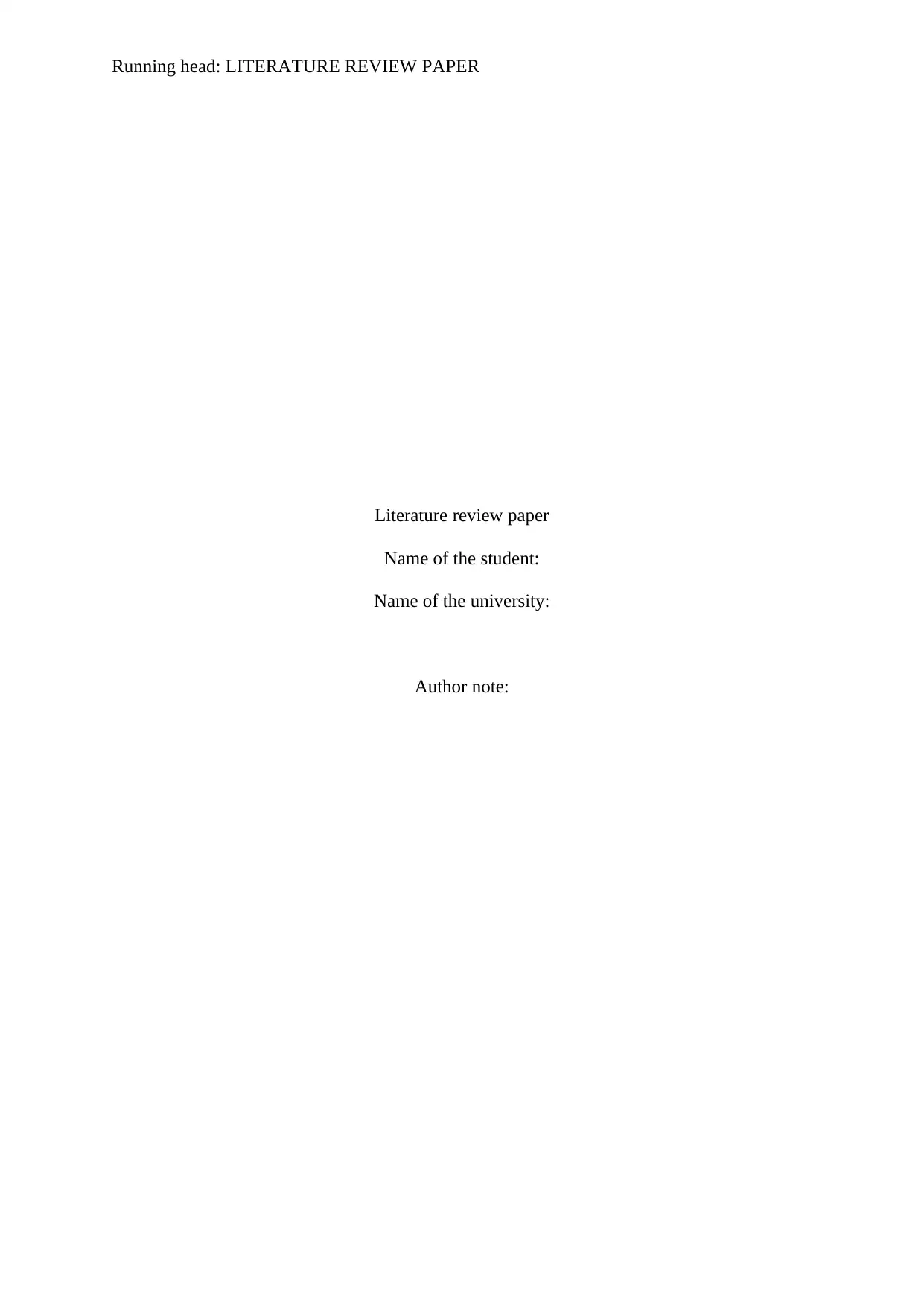
Running head: LITERATURE REVIEW PAPER
Literature review paper
Name of the student:
Name of the university:
Author note:
Literature review paper
Name of the student:
Name of the university:
Author note:
Paraphrase This Document
Need a fresh take? Get an instant paraphrase of this document with our AI Paraphraser
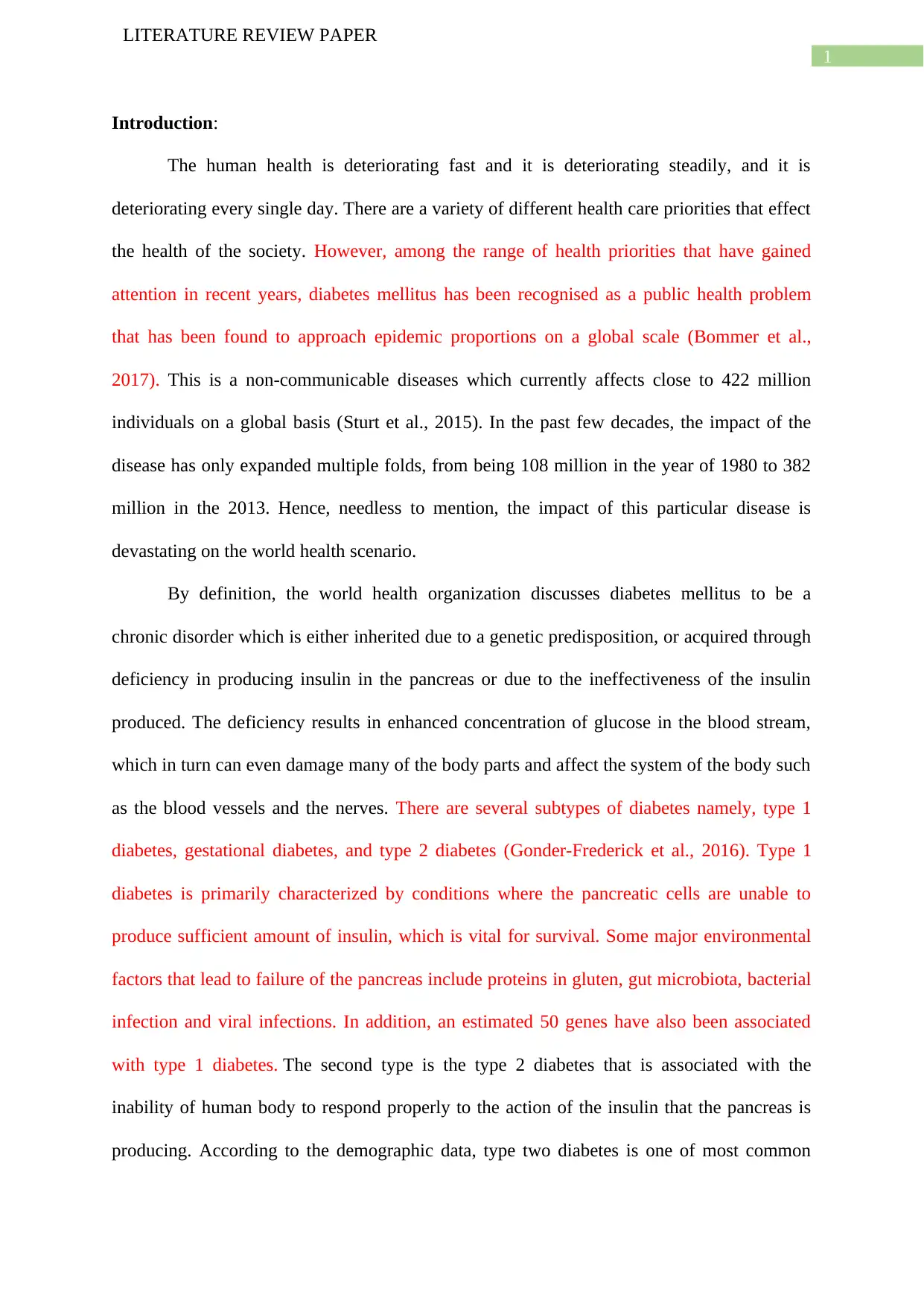
1
LITERATURE REVIEW PAPER
Introduction:
The human health is deteriorating fast and it is deteriorating steadily, and it is
deteriorating every single day. There are a variety of different health care priorities that effect
the health of the society. However, among the range of health priorities that have gained
attention in recent years, diabetes mellitus has been recognised as a public health problem
that has been found to approach epidemic proportions on a global scale (Bommer et al.,
2017). This is a non-communicable diseases which currently affects close to 422 million
individuals on a global basis (Sturt et al., 2015). In the past few decades, the impact of the
disease has only expanded multiple folds, from being 108 million in the year of 1980 to 382
million in the 2013. Hence, needless to mention, the impact of this particular disease is
devastating on the world health scenario.
By definition, the world health organization discusses diabetes mellitus to be a
chronic disorder which is either inherited due to a genetic predisposition, or acquired through
deficiency in producing insulin in the pancreas or due to the ineffectiveness of the insulin
produced. The deficiency results in enhanced concentration of glucose in the blood stream,
which in turn can even damage many of the body parts and affect the system of the body such
as the blood vessels and the nerves. There are several subtypes of diabetes namely, type 1
diabetes, gestational diabetes, and type 2 diabetes (Gonder-Frederick et al., 2016). Type 1
diabetes is primarily characterized by conditions where the pancreatic cells are unable to
produce sufficient amount of insulin, which is vital for survival. Some major environmental
factors that lead to failure of the pancreas include proteins in gluten, gut microbiota, bacterial
infection and viral infections. In addition, an estimated 50 genes have also been associated
with type 1 diabetes. The second type is the type 2 diabetes that is associated with the
inability of human body to respond properly to the action of the insulin that the pancreas is
producing. According to the demographic data, type two diabetes is one of most common
LITERATURE REVIEW PAPER
Introduction:
The human health is deteriorating fast and it is deteriorating steadily, and it is
deteriorating every single day. There are a variety of different health care priorities that effect
the health of the society. However, among the range of health priorities that have gained
attention in recent years, diabetes mellitus has been recognised as a public health problem
that has been found to approach epidemic proportions on a global scale (Bommer et al.,
2017). This is a non-communicable diseases which currently affects close to 422 million
individuals on a global basis (Sturt et al., 2015). In the past few decades, the impact of the
disease has only expanded multiple folds, from being 108 million in the year of 1980 to 382
million in the 2013. Hence, needless to mention, the impact of this particular disease is
devastating on the world health scenario.
By definition, the world health organization discusses diabetes mellitus to be a
chronic disorder which is either inherited due to a genetic predisposition, or acquired through
deficiency in producing insulin in the pancreas or due to the ineffectiveness of the insulin
produced. The deficiency results in enhanced concentration of glucose in the blood stream,
which in turn can even damage many of the body parts and affect the system of the body such
as the blood vessels and the nerves. There are several subtypes of diabetes namely, type 1
diabetes, gestational diabetes, and type 2 diabetes (Gonder-Frederick et al., 2016). Type 1
diabetes is primarily characterized by conditions where the pancreatic cells are unable to
produce sufficient amount of insulin, which is vital for survival. Some major environmental
factors that lead to failure of the pancreas include proteins in gluten, gut microbiota, bacterial
infection and viral infections. In addition, an estimated 50 genes have also been associated
with type 1 diabetes. The second type is the type 2 diabetes that is associated with the
inability of human body to respond properly to the action of the insulin that the pancreas is
producing. According to the demographic data, type two diabetes is one of most common
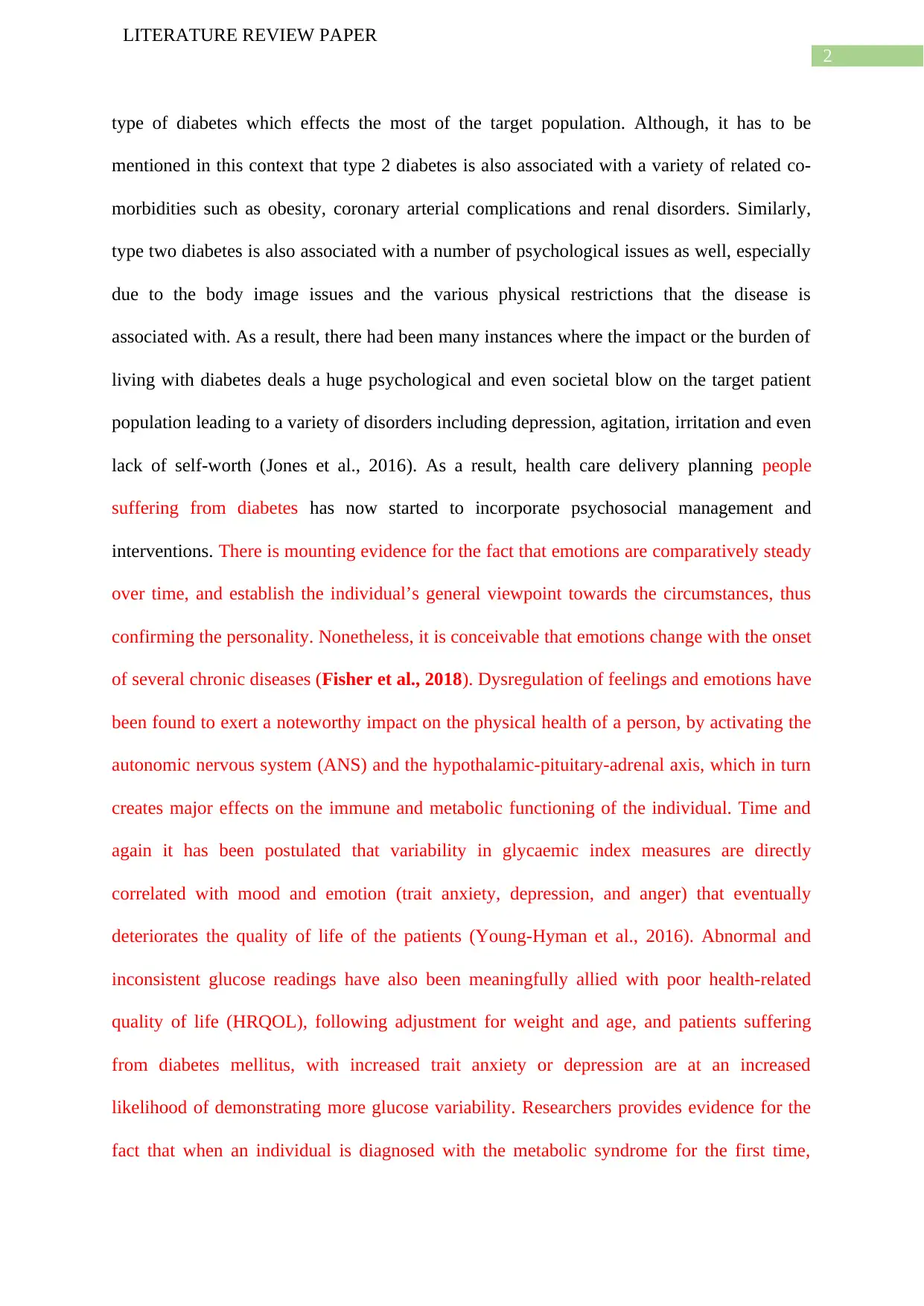
2
LITERATURE REVIEW PAPER
type of diabetes which effects the most of the target population. Although, it has to be
mentioned in this context that type 2 diabetes is also associated with a variety of related co-
morbidities such as obesity, coronary arterial complications and renal disorders. Similarly,
type two diabetes is also associated with a number of psychological issues as well, especially
due to the body image issues and the various physical restrictions that the disease is
associated with. As a result, there had been many instances where the impact or the burden of
living with diabetes deals a huge psychological and even societal blow on the target patient
population leading to a variety of disorders including depression, agitation, irritation and even
lack of self-worth (Jones et al., 2016). As a result, health care delivery planning people
suffering from diabetes has now started to incorporate psychosocial management and
interventions. There is mounting evidence for the fact that emotions are comparatively steady
over time, and establish the individual’s general viewpoint towards the circumstances, thus
confirming the personality. Nonetheless, it is conceivable that emotions change with the onset
of several chronic diseases (Fisher et al., 2018). Dysregulation of feelings and emotions have
been found to exert a noteworthy impact on the physical health of a person, by activating the
autonomic nervous system (ANS) and the hypothalamic-pituitary-adrenal axis, which in turn
creates major effects on the immune and metabolic functioning of the individual. Time and
again it has been postulated that variability in glycaemic index measures are directly
correlated with mood and emotion (trait anxiety, depression, and anger) that eventually
deteriorates the quality of life of the patients (Young-Hyman et al., 2016). Abnormal and
inconsistent glucose readings have also been meaningfully allied with poor health-related
quality of life (HRQOL), following adjustment for weight and age, and patients suffering
from diabetes mellitus, with increased trait anxiety or depression are at an increased
likelihood of demonstrating more glucose variability. Researchers provides evidence for the
fact that when an individual is diagnosed with the metabolic syndrome for the first time,
LITERATURE REVIEW PAPER
type of diabetes which effects the most of the target population. Although, it has to be
mentioned in this context that type 2 diabetes is also associated with a variety of related co-
morbidities such as obesity, coronary arterial complications and renal disorders. Similarly,
type two diabetes is also associated with a number of psychological issues as well, especially
due to the body image issues and the various physical restrictions that the disease is
associated with. As a result, there had been many instances where the impact or the burden of
living with diabetes deals a huge psychological and even societal blow on the target patient
population leading to a variety of disorders including depression, agitation, irritation and even
lack of self-worth (Jones et al., 2016). As a result, health care delivery planning people
suffering from diabetes has now started to incorporate psychosocial management and
interventions. There is mounting evidence for the fact that emotions are comparatively steady
over time, and establish the individual’s general viewpoint towards the circumstances, thus
confirming the personality. Nonetheless, it is conceivable that emotions change with the onset
of several chronic diseases (Fisher et al., 2018). Dysregulation of feelings and emotions have
been found to exert a noteworthy impact on the physical health of a person, by activating the
autonomic nervous system (ANS) and the hypothalamic-pituitary-adrenal axis, which in turn
creates major effects on the immune and metabolic functioning of the individual. Time and
again it has been postulated that variability in glycaemic index measures are directly
correlated with mood and emotion (trait anxiety, depression, and anger) that eventually
deteriorates the quality of life of the patients (Young-Hyman et al., 2016). Abnormal and
inconsistent glucose readings have also been meaningfully allied with poor health-related
quality of life (HRQOL), following adjustment for weight and age, and patients suffering
from diabetes mellitus, with increased trait anxiety or depression are at an increased
likelihood of demonstrating more glucose variability. Researchers provides evidence for the
fact that when an individual is diagnosed with the metabolic syndrome for the first time,
⊘ This is a preview!⊘
Do you want full access?
Subscribe today to unlock all pages.

Trusted by 1+ million students worldwide
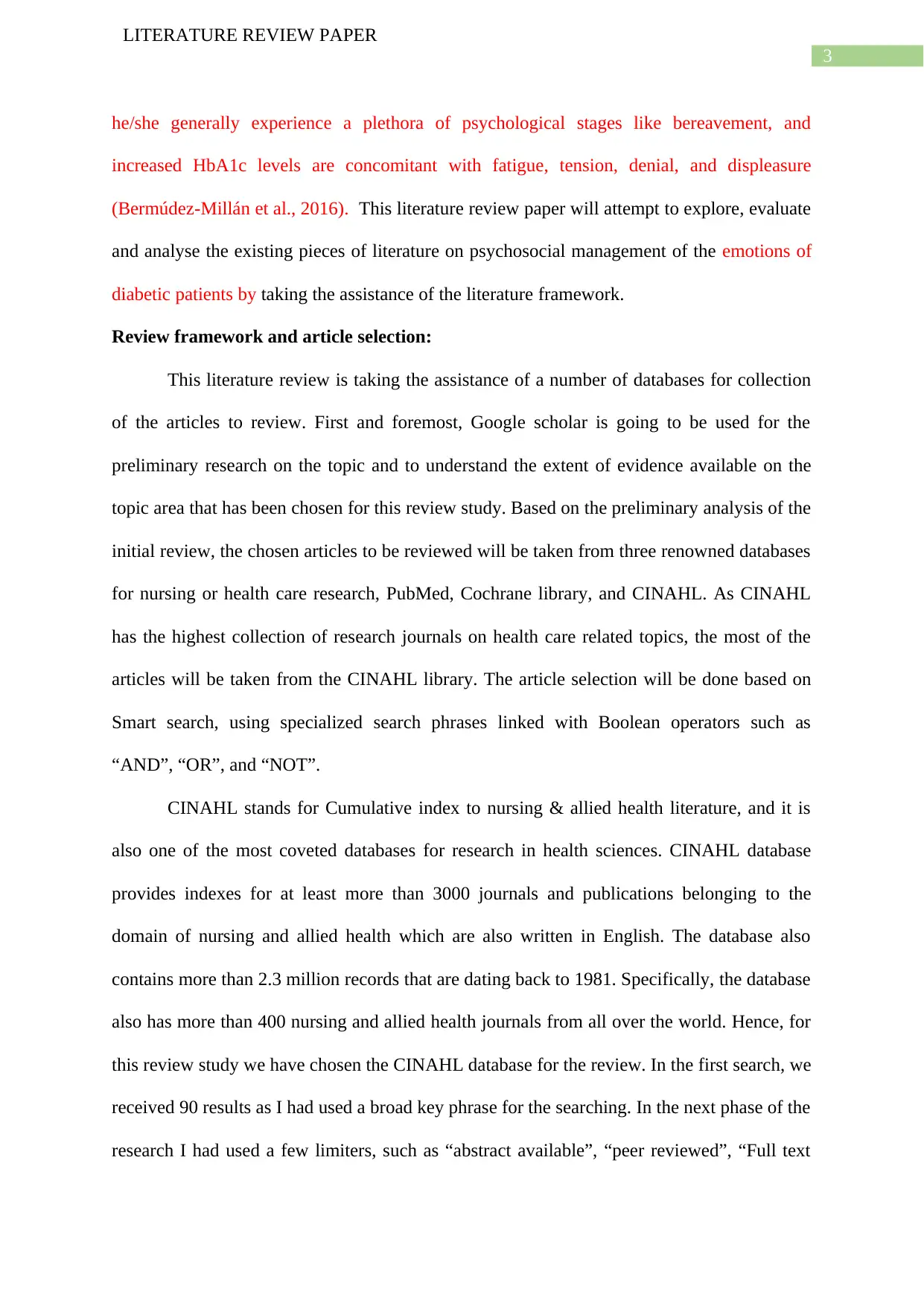
3
LITERATURE REVIEW PAPER
he/she generally experience a plethora of psychological stages like bereavement, and
increased HbA1c levels are concomitant with fatigue, tension, denial, and displeasure
(Bermúdez-Millán et al., 2016). This literature review paper will attempt to explore, evaluate
and analyse the existing pieces of literature on psychosocial management of the emotions of
diabetic patients by taking the assistance of the literature framework.
Review framework and article selection:
This literature review is taking the assistance of a number of databases for collection
of the articles to review. First and foremost, Google scholar is going to be used for the
preliminary research on the topic and to understand the extent of evidence available on the
topic area that has been chosen for this review study. Based on the preliminary analysis of the
initial review, the chosen articles to be reviewed will be taken from three renowned databases
for nursing or health care research, PubMed, Cochrane library, and CINAHL. As CINAHL
has the highest collection of research journals on health care related topics, the most of the
articles will be taken from the CINAHL library. The article selection will be done based on
Smart search, using specialized search phrases linked with Boolean operators such as
“AND”, “OR”, and “NOT”.
CINAHL stands for Cumulative index to nursing & allied health literature, and it is
also one of the most coveted databases for research in health sciences. CINAHL database
provides indexes for at least more than 3000 journals and publications belonging to the
domain of nursing and allied health which are also written in English. The database also
contains more than 2.3 million records that are dating back to 1981. Specifically, the database
also has more than 400 nursing and allied health journals from all over the world. Hence, for
this review study we have chosen the CINAHL database for the review. In the first search, we
received 90 results as I had used a broad key phrase for the searching. In the next phase of the
research I had used a few limiters, such as “abstract available”, “peer reviewed”, “Full text
LITERATURE REVIEW PAPER
he/she generally experience a plethora of psychological stages like bereavement, and
increased HbA1c levels are concomitant with fatigue, tension, denial, and displeasure
(Bermúdez-Millán et al., 2016). This literature review paper will attempt to explore, evaluate
and analyse the existing pieces of literature on psychosocial management of the emotions of
diabetic patients by taking the assistance of the literature framework.
Review framework and article selection:
This literature review is taking the assistance of a number of databases for collection
of the articles to review. First and foremost, Google scholar is going to be used for the
preliminary research on the topic and to understand the extent of evidence available on the
topic area that has been chosen for this review study. Based on the preliminary analysis of the
initial review, the chosen articles to be reviewed will be taken from three renowned databases
for nursing or health care research, PubMed, Cochrane library, and CINAHL. As CINAHL
has the highest collection of research journals on health care related topics, the most of the
articles will be taken from the CINAHL library. The article selection will be done based on
Smart search, using specialized search phrases linked with Boolean operators such as
“AND”, “OR”, and “NOT”.
CINAHL stands for Cumulative index to nursing & allied health literature, and it is
also one of the most coveted databases for research in health sciences. CINAHL database
provides indexes for at least more than 3000 journals and publications belonging to the
domain of nursing and allied health which are also written in English. The database also
contains more than 2.3 million records that are dating back to 1981. Specifically, the database
also has more than 400 nursing and allied health journals from all over the world. Hence, for
this review study we have chosen the CINAHL database for the review. In the first search, we
received 90 results as I had used a broad key phrase for the searching. In the next phase of the
research I had used a few limiters, such as “abstract available”, “peer reviewed”, “Full text
Paraphrase This Document
Need a fresh take? Get an instant paraphrase of this document with our AI Paraphraser
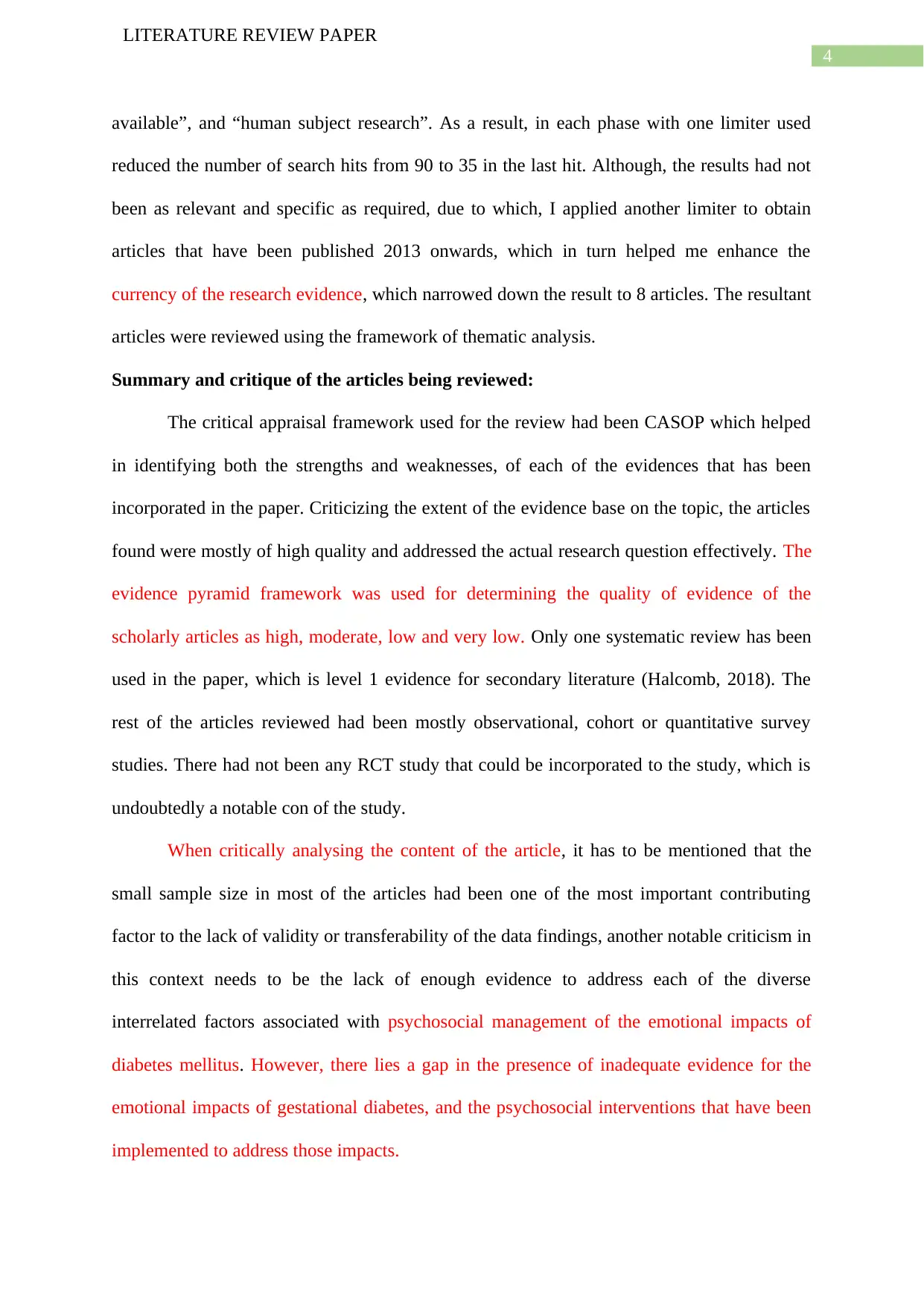
4
LITERATURE REVIEW PAPER
available”, and “human subject research”. As a result, in each phase with one limiter used
reduced the number of search hits from 90 to 35 in the last hit. Although, the results had not
been as relevant and specific as required, due to which, I applied another limiter to obtain
articles that have been published 2013 onwards, which in turn helped me enhance the
currency of the research evidence, which narrowed down the result to 8 articles. The resultant
articles were reviewed using the framework of thematic analysis.
Summary and critique of the articles being reviewed:
The critical appraisal framework used for the review had been CASOP which helped
in identifying both the strengths and weaknesses, of each of the evidences that has been
incorporated in the paper. Criticizing the extent of the evidence base on the topic, the articles
found were mostly of high quality and addressed the actual research question effectively. The
evidence pyramid framework was used for determining the quality of evidence of the
scholarly articles as high, moderate, low and very low. Only one systematic review has been
used in the paper, which is level 1 evidence for secondary literature (Halcomb, 2018). The
rest of the articles reviewed had been mostly observational, cohort or quantitative survey
studies. There had not been any RCT study that could be incorporated to the study, which is
undoubtedly a notable con of the study.
When critically analysing the content of the article, it has to be mentioned that the
small sample size in most of the articles had been one of the most important contributing
factor to the lack of validity or transferability of the data findings, another notable criticism in
this context needs to be the lack of enough evidence to address each of the diverse
interrelated factors associated with psychosocial management of the emotional impacts of
diabetes mellitus. However, there lies a gap in the presence of inadequate evidence for the
emotional impacts of gestational diabetes, and the psychosocial interventions that have been
implemented to address those impacts.
LITERATURE REVIEW PAPER
available”, and “human subject research”. As a result, in each phase with one limiter used
reduced the number of search hits from 90 to 35 in the last hit. Although, the results had not
been as relevant and specific as required, due to which, I applied another limiter to obtain
articles that have been published 2013 onwards, which in turn helped me enhance the
currency of the research evidence, which narrowed down the result to 8 articles. The resultant
articles were reviewed using the framework of thematic analysis.
Summary and critique of the articles being reviewed:
The critical appraisal framework used for the review had been CASOP which helped
in identifying both the strengths and weaknesses, of each of the evidences that has been
incorporated in the paper. Criticizing the extent of the evidence base on the topic, the articles
found were mostly of high quality and addressed the actual research question effectively. The
evidence pyramid framework was used for determining the quality of evidence of the
scholarly articles as high, moderate, low and very low. Only one systematic review has been
used in the paper, which is level 1 evidence for secondary literature (Halcomb, 2018). The
rest of the articles reviewed had been mostly observational, cohort or quantitative survey
studies. There had not been any RCT study that could be incorporated to the study, which is
undoubtedly a notable con of the study.
When critically analysing the content of the article, it has to be mentioned that the
small sample size in most of the articles had been one of the most important contributing
factor to the lack of validity or transferability of the data findings, another notable criticism in
this context needs to be the lack of enough evidence to address each of the diverse
interrelated factors associated with psychosocial management of the emotional impacts of
diabetes mellitus. However, there lies a gap in the presence of inadequate evidence for the
emotional impacts of gestational diabetes, and the psychosocial interventions that have been
implemented to address those impacts.
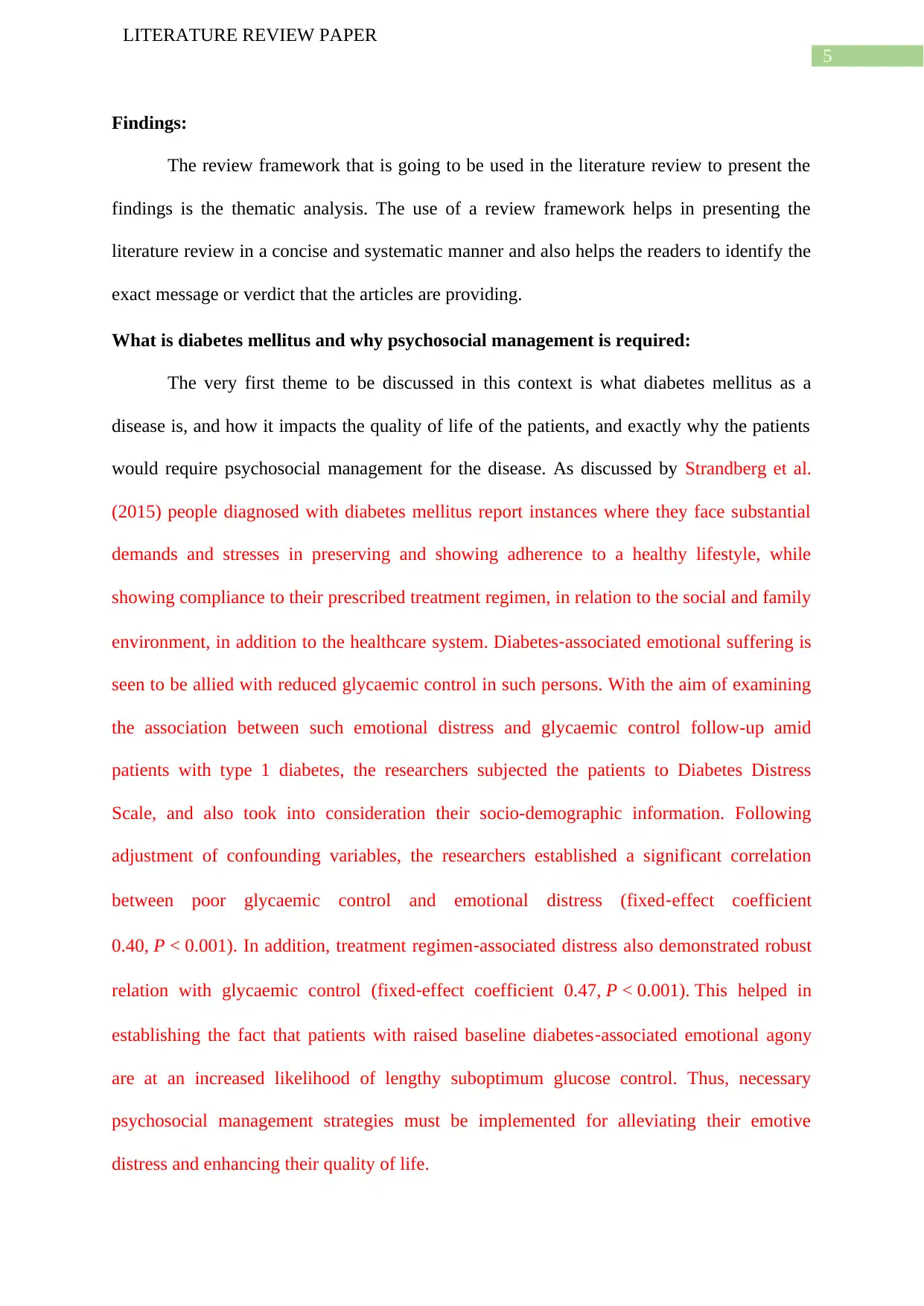
5
LITERATURE REVIEW PAPER
Findings:
The review framework that is going to be used in the literature review to present the
findings is the thematic analysis. The use of a review framework helps in presenting the
literature review in a concise and systematic manner and also helps the readers to identify the
exact message or verdict that the articles are providing.
What is diabetes mellitus and why psychosocial management is required:
The very first theme to be discussed in this context is what diabetes mellitus as a
disease is, and how it impacts the quality of life of the patients, and exactly why the patients
would require psychosocial management for the disease. As discussed by Strandberg et al.
(2015) people diagnosed with diabetes mellitus report instances where they face substantial
demands and stresses in preserving and showing adherence to a healthy lifestyle, while
showing compliance to their prescribed treatment regimen, in relation to the social and family
environment, in addition to the healthcare system. Diabetes‐associated emotional suffering is
seen to be allied with reduced glycaemic control in such persons. With the aim of examining
the association between such emotional distress and glycaemic control follow-up amid
patients with type 1 diabetes, the researchers subjected the patients to Diabetes Distress
Scale, and also took into consideration their socio-demographic information. Following
adjustment of confounding variables, the researchers established a significant correlation
between poor glycaemic control and emotional distress (fixed‐effect coefficient
0.40, P < 0.001). In addition, treatment regimen‐associated distress also demonstrated robust
relation with glycaemic control (fixed‐effect coefficient 0.47, P < 0.001). This helped in
establishing the fact that patients with raised baseline diabetes‐associated emotional agony
are at an increased likelihood of lengthy suboptimum glucose control. Thus, necessary
psychosocial management strategies must be implemented for alleviating their emotive
distress and enhancing their quality of life.
LITERATURE REVIEW PAPER
Findings:
The review framework that is going to be used in the literature review to present the
findings is the thematic analysis. The use of a review framework helps in presenting the
literature review in a concise and systematic manner and also helps the readers to identify the
exact message or verdict that the articles are providing.
What is diabetes mellitus and why psychosocial management is required:
The very first theme to be discussed in this context is what diabetes mellitus as a
disease is, and how it impacts the quality of life of the patients, and exactly why the patients
would require psychosocial management for the disease. As discussed by Strandberg et al.
(2015) people diagnosed with diabetes mellitus report instances where they face substantial
demands and stresses in preserving and showing adherence to a healthy lifestyle, while
showing compliance to their prescribed treatment regimen, in relation to the social and family
environment, in addition to the healthcare system. Diabetes‐associated emotional suffering is
seen to be allied with reduced glycaemic control in such persons. With the aim of examining
the association between such emotional distress and glycaemic control follow-up amid
patients with type 1 diabetes, the researchers subjected the patients to Diabetes Distress
Scale, and also took into consideration their socio-demographic information. Following
adjustment of confounding variables, the researchers established a significant correlation
between poor glycaemic control and emotional distress (fixed‐effect coefficient
0.40, P < 0.001). In addition, treatment regimen‐associated distress also demonstrated robust
relation with glycaemic control (fixed‐effect coefficient 0.47, P < 0.001). This helped in
establishing the fact that patients with raised baseline diabetes‐associated emotional agony
are at an increased likelihood of lengthy suboptimum glucose control. Thus, necessary
psychosocial management strategies must be implemented for alleviating their emotive
distress and enhancing their quality of life.
⊘ This is a preview!⊘
Do you want full access?
Subscribe today to unlock all pages.

Trusted by 1+ million students worldwide
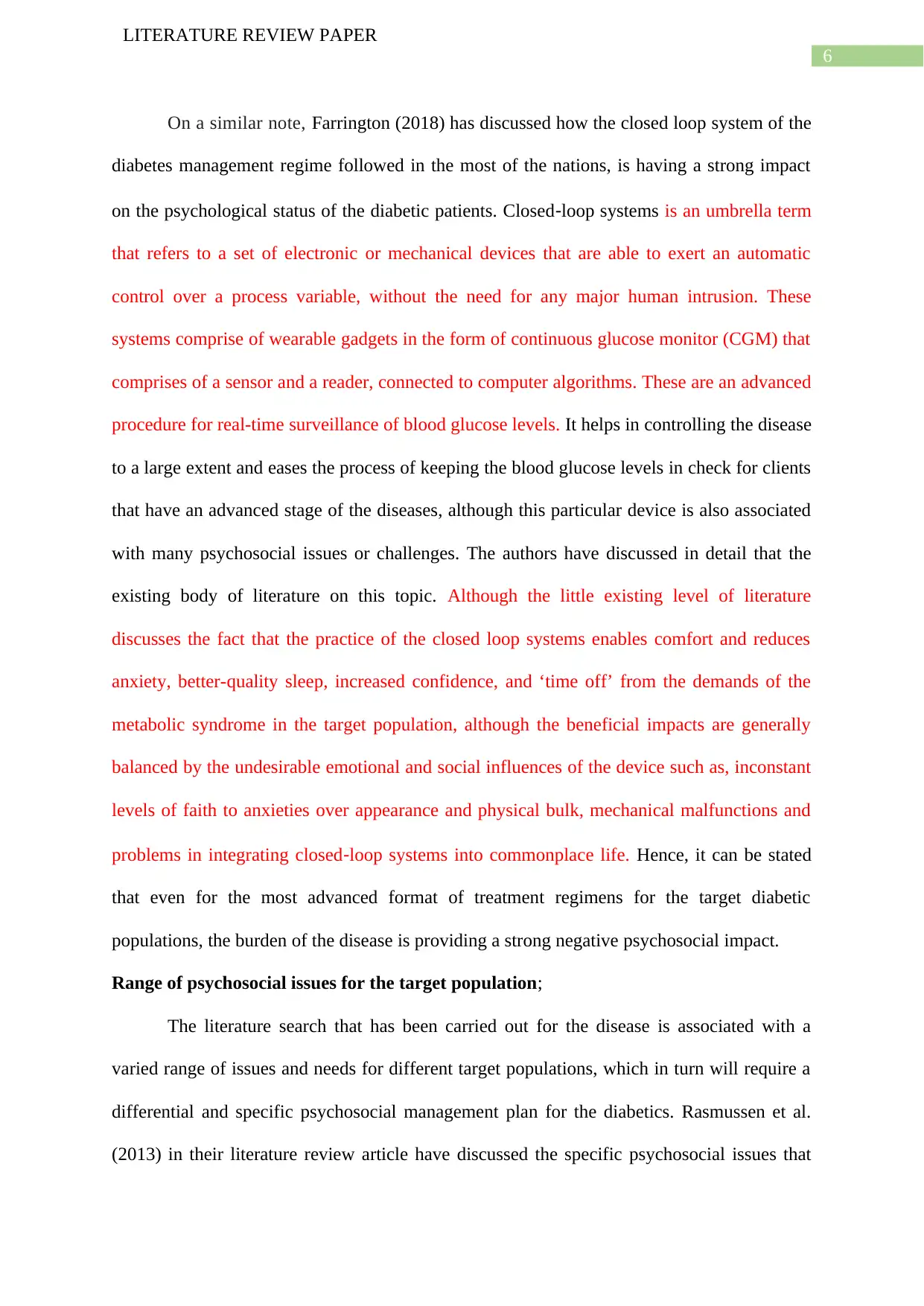
6
LITERATURE REVIEW PAPER
On a similar note, Farrington (2018) has discussed how the closed loop system of the
diabetes management regime followed in the most of the nations, is having a strong impact
on the psychological status of the diabetic patients. Closed‐loop systems is an umbrella term
that refers to a set of electronic or mechanical devices that are able to exert an automatic
control over a process variable, without the need for any major human intrusion. These
systems comprise of wearable gadgets in the form of continuous glucose monitor (CGM) that
comprises of a sensor and a reader, connected to computer algorithms. These are an advanced
procedure for real-time surveillance of blood glucose levels. It helps in controlling the disease
to a large extent and eases the process of keeping the blood glucose levels in check for clients
that have an advanced stage of the diseases, although this particular device is also associated
with many psychosocial issues or challenges. The authors have discussed in detail that the
existing body of literature on this topic. Although the little existing level of literature
discusses the fact that the practice of the closed loop systems enables comfort and reduces
anxiety, better-quality sleep, increased confidence, and ‘time off’ from the demands of the
metabolic syndrome in the target population, although the beneficial impacts are generally
balanced by the undesirable emotional and social influences of the device such as, inconstant
levels of faith to anxieties over appearance and physical bulk, mechanical malfunctions and
problems in integrating closed‐loop systems into commonplace life. Hence, it can be stated
that even for the most advanced format of treatment regimens for the target diabetic
populations, the burden of the disease is providing a strong negative psychosocial impact.
Range of psychosocial issues for the target population;
The literature search that has been carried out for the disease is associated with a
varied range of issues and needs for different target populations, which in turn will require a
differential and specific psychosocial management plan for the diabetics. Rasmussen et al.
(2013) in their literature review article have discussed the specific psychosocial issues that
LITERATURE REVIEW PAPER
On a similar note, Farrington (2018) has discussed how the closed loop system of the
diabetes management regime followed in the most of the nations, is having a strong impact
on the psychological status of the diabetic patients. Closed‐loop systems is an umbrella term
that refers to a set of electronic or mechanical devices that are able to exert an automatic
control over a process variable, without the need for any major human intrusion. These
systems comprise of wearable gadgets in the form of continuous glucose monitor (CGM) that
comprises of a sensor and a reader, connected to computer algorithms. These are an advanced
procedure for real-time surveillance of blood glucose levels. It helps in controlling the disease
to a large extent and eases the process of keeping the blood glucose levels in check for clients
that have an advanced stage of the diseases, although this particular device is also associated
with many psychosocial issues or challenges. The authors have discussed in detail that the
existing body of literature on this topic. Although the little existing level of literature
discusses the fact that the practice of the closed loop systems enables comfort and reduces
anxiety, better-quality sleep, increased confidence, and ‘time off’ from the demands of the
metabolic syndrome in the target population, although the beneficial impacts are generally
balanced by the undesirable emotional and social influences of the device such as, inconstant
levels of faith to anxieties over appearance and physical bulk, mechanical malfunctions and
problems in integrating closed‐loop systems into commonplace life. Hence, it can be stated
that even for the most advanced format of treatment regimens for the target diabetic
populations, the burden of the disease is providing a strong negative psychosocial impact.
Range of psychosocial issues for the target population;
The literature search that has been carried out for the disease is associated with a
varied range of issues and needs for different target populations, which in turn will require a
differential and specific psychosocial management plan for the diabetics. Rasmussen et al.
(2013) in their literature review article have discussed the specific psychosocial issues that
Paraphrase This Document
Need a fresh take? Get an instant paraphrase of this document with our AI Paraphraser
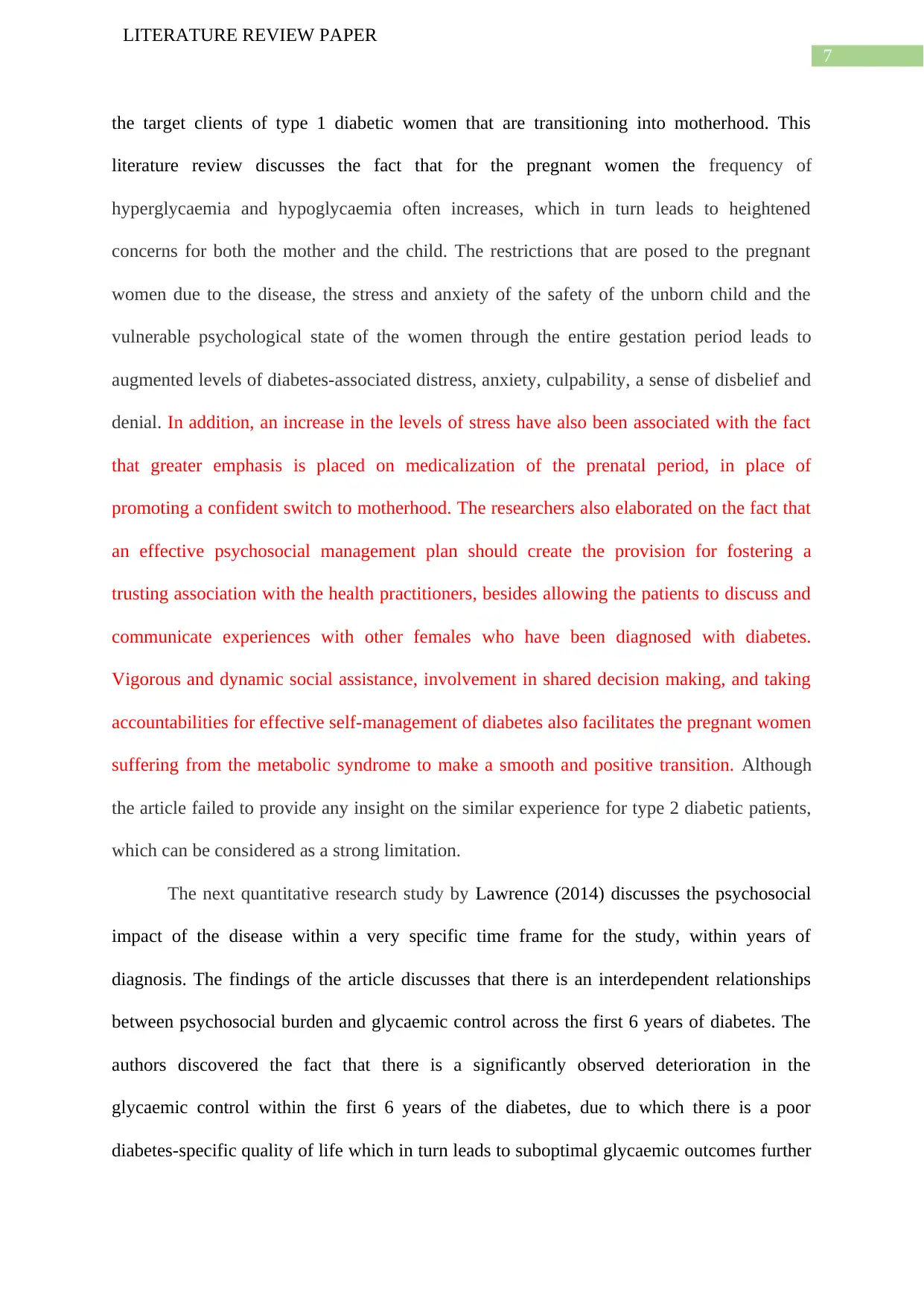
7
LITERATURE REVIEW PAPER
the target clients of type 1 diabetic women that are transitioning into motherhood. This
literature review discusses the fact that for the pregnant women the frequency of
hyperglycaemia and hypoglycaemia often increases, which in turn leads to heightened
concerns for both the mother and the child. The restrictions that are posed to the pregnant
women due to the disease, the stress and anxiety of the safety of the unborn child and the
vulnerable psychological state of the women through the entire gestation period leads to
augmented levels of diabetes-associated distress, anxiety, culpability, a sense of disbelief and
denial. In addition, an increase in the levels of stress have also been associated with the fact
that greater emphasis is placed on medicalization of the prenatal period, in place of
promoting a confident switch to motherhood. The researchers also elaborated on the fact that
an effective psychosocial management plan should create the provision for fostering a
trusting association with the health practitioners, besides allowing the patients to discuss and
communicate experiences with other females who have been diagnosed with diabetes.
Vigorous and dynamic social assistance, involvement in shared decision making, and taking
accountabilities for effective self-management of diabetes also facilitates the pregnant women
suffering from the metabolic syndrome to make a smooth and positive transition. Although
the article failed to provide any insight on the similar experience for type 2 diabetic patients,
which can be considered as a strong limitation.
The next quantitative research study by Lawrence (2014) discusses the psychosocial
impact of the disease within a very specific time frame for the study, within years of
diagnosis. The findings of the article discusses that there is an interdependent relationships
between psychosocial burden and glycaemic control across the first 6 years of diabetes. The
authors discovered the fact that there is a significantly observed deterioration in the
glycaemic control within the first 6 years of the diabetes, due to which there is a poor
diabetes-specific quality of life which in turn leads to suboptimal glycaemic outcomes further
LITERATURE REVIEW PAPER
the target clients of type 1 diabetic women that are transitioning into motherhood. This
literature review discusses the fact that for the pregnant women the frequency of
hyperglycaemia and hypoglycaemia often increases, which in turn leads to heightened
concerns for both the mother and the child. The restrictions that are posed to the pregnant
women due to the disease, the stress and anxiety of the safety of the unborn child and the
vulnerable psychological state of the women through the entire gestation period leads to
augmented levels of diabetes-associated distress, anxiety, culpability, a sense of disbelief and
denial. In addition, an increase in the levels of stress have also been associated with the fact
that greater emphasis is placed on medicalization of the prenatal period, in place of
promoting a confident switch to motherhood. The researchers also elaborated on the fact that
an effective psychosocial management plan should create the provision for fostering a
trusting association with the health practitioners, besides allowing the patients to discuss and
communicate experiences with other females who have been diagnosed with diabetes.
Vigorous and dynamic social assistance, involvement in shared decision making, and taking
accountabilities for effective self-management of diabetes also facilitates the pregnant women
suffering from the metabolic syndrome to make a smooth and positive transition. Although
the article failed to provide any insight on the similar experience for type 2 diabetic patients,
which can be considered as a strong limitation.
The next quantitative research study by Lawrence (2014) discusses the psychosocial
impact of the disease within a very specific time frame for the study, within years of
diagnosis. The findings of the article discusses that there is an interdependent relationships
between psychosocial burden and glycaemic control across the first 6 years of diabetes. The
authors discovered the fact that there is a significantly observed deterioration in the
glycaemic control within the first 6 years of the diabetes, due to which there is a poor
diabetes-specific quality of life which in turn leads to suboptimal glycaemic outcomes further
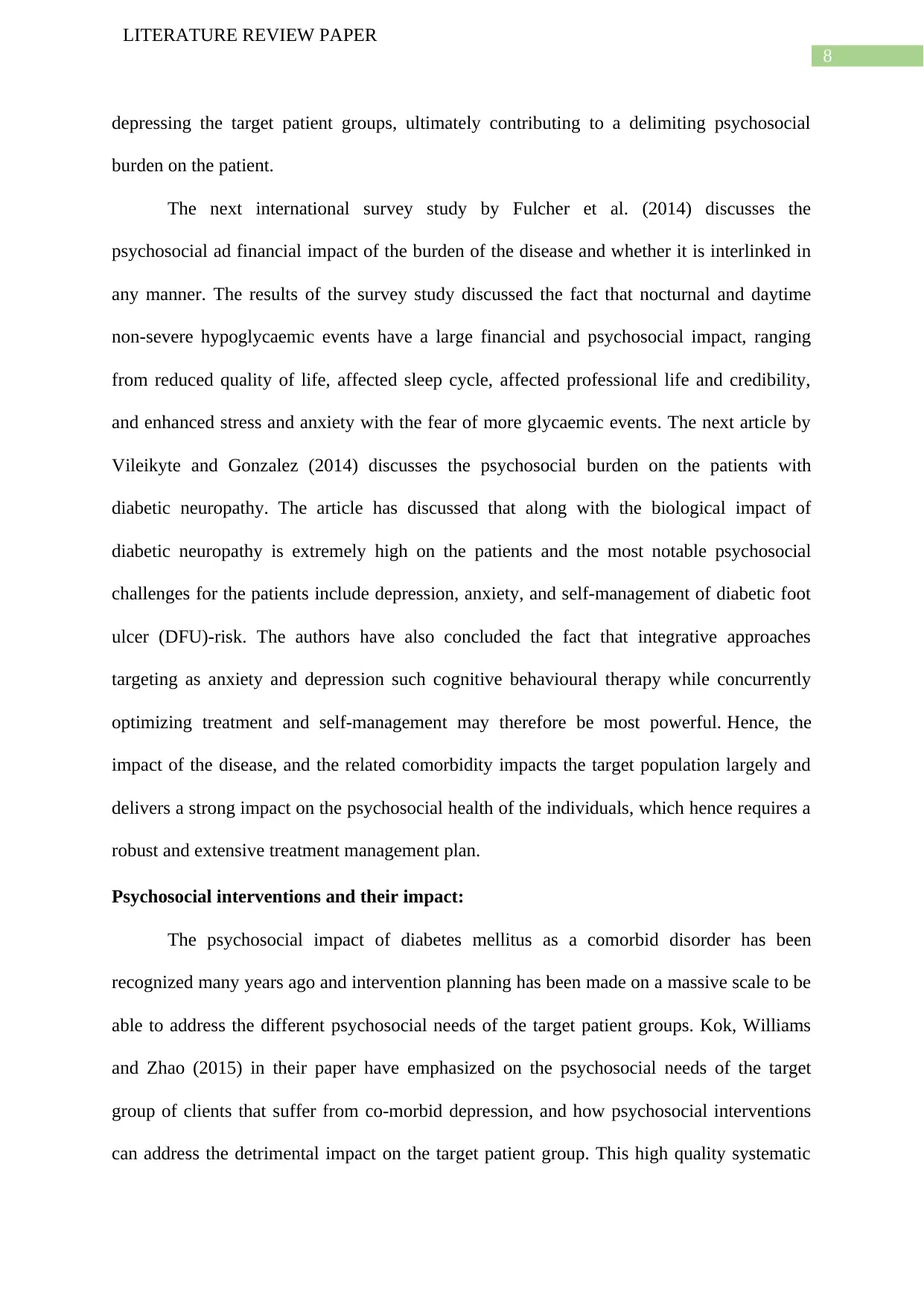
8
LITERATURE REVIEW PAPER
depressing the target patient groups, ultimately contributing to a delimiting psychosocial
burden on the patient.
The next international survey study by Fulcher et al. (2014) discusses the
psychosocial ad financial impact of the burden of the disease and whether it is interlinked in
any manner. The results of the survey study discussed the fact that nocturnal and daytime
non-severe hypoglycaemic events have a large financial and psychosocial impact, ranging
from reduced quality of life, affected sleep cycle, affected professional life and credibility,
and enhanced stress and anxiety with the fear of more glycaemic events. The next article by
Vileikyte and Gonzalez (2014) discusses the psychosocial burden on the patients with
diabetic neuropathy. The article has discussed that along with the biological impact of
diabetic neuropathy is extremely high on the patients and the most notable psychosocial
challenges for the patients include depression, anxiety, and self-management of diabetic foot
ulcer (DFU)-risk. The authors have also concluded the fact that integrative approaches
targeting as anxiety and depression such cognitive behavioural therapy while concurrently
optimizing treatment and self-management may therefore be most powerful. Hence, the
impact of the disease, and the related comorbidity impacts the target population largely and
delivers a strong impact on the psychosocial health of the individuals, which hence requires a
robust and extensive treatment management plan.
Psychosocial interventions and their impact:
The psychosocial impact of diabetes mellitus as a comorbid disorder has been
recognized many years ago and intervention planning has been made on a massive scale to be
able to address the different psychosocial needs of the target patient groups. Kok, Williams
and Zhao (2015) in their paper have emphasized on the psychosocial needs of the target
group of clients that suffer from co-morbid depression, and how psychosocial interventions
can address the detrimental impact on the target patient group. This high quality systematic
LITERATURE REVIEW PAPER
depressing the target patient groups, ultimately contributing to a delimiting psychosocial
burden on the patient.
The next international survey study by Fulcher et al. (2014) discusses the
psychosocial ad financial impact of the burden of the disease and whether it is interlinked in
any manner. The results of the survey study discussed the fact that nocturnal and daytime
non-severe hypoglycaemic events have a large financial and psychosocial impact, ranging
from reduced quality of life, affected sleep cycle, affected professional life and credibility,
and enhanced stress and anxiety with the fear of more glycaemic events. The next article by
Vileikyte and Gonzalez (2014) discusses the psychosocial burden on the patients with
diabetic neuropathy. The article has discussed that along with the biological impact of
diabetic neuropathy is extremely high on the patients and the most notable psychosocial
challenges for the patients include depression, anxiety, and self-management of diabetic foot
ulcer (DFU)-risk. The authors have also concluded the fact that integrative approaches
targeting as anxiety and depression such cognitive behavioural therapy while concurrently
optimizing treatment and self-management may therefore be most powerful. Hence, the
impact of the disease, and the related comorbidity impacts the target population largely and
delivers a strong impact on the psychosocial health of the individuals, which hence requires a
robust and extensive treatment management plan.
Psychosocial interventions and their impact:
The psychosocial impact of diabetes mellitus as a comorbid disorder has been
recognized many years ago and intervention planning has been made on a massive scale to be
able to address the different psychosocial needs of the target patient groups. Kok, Williams
and Zhao (2015) in their paper have emphasized on the psychosocial needs of the target
group of clients that suffer from co-morbid depression, and how psychosocial interventions
can address the detrimental impact on the target patient group. This high quality systematic
⊘ This is a preview!⊘
Do you want full access?
Subscribe today to unlock all pages.

Trusted by 1+ million students worldwide
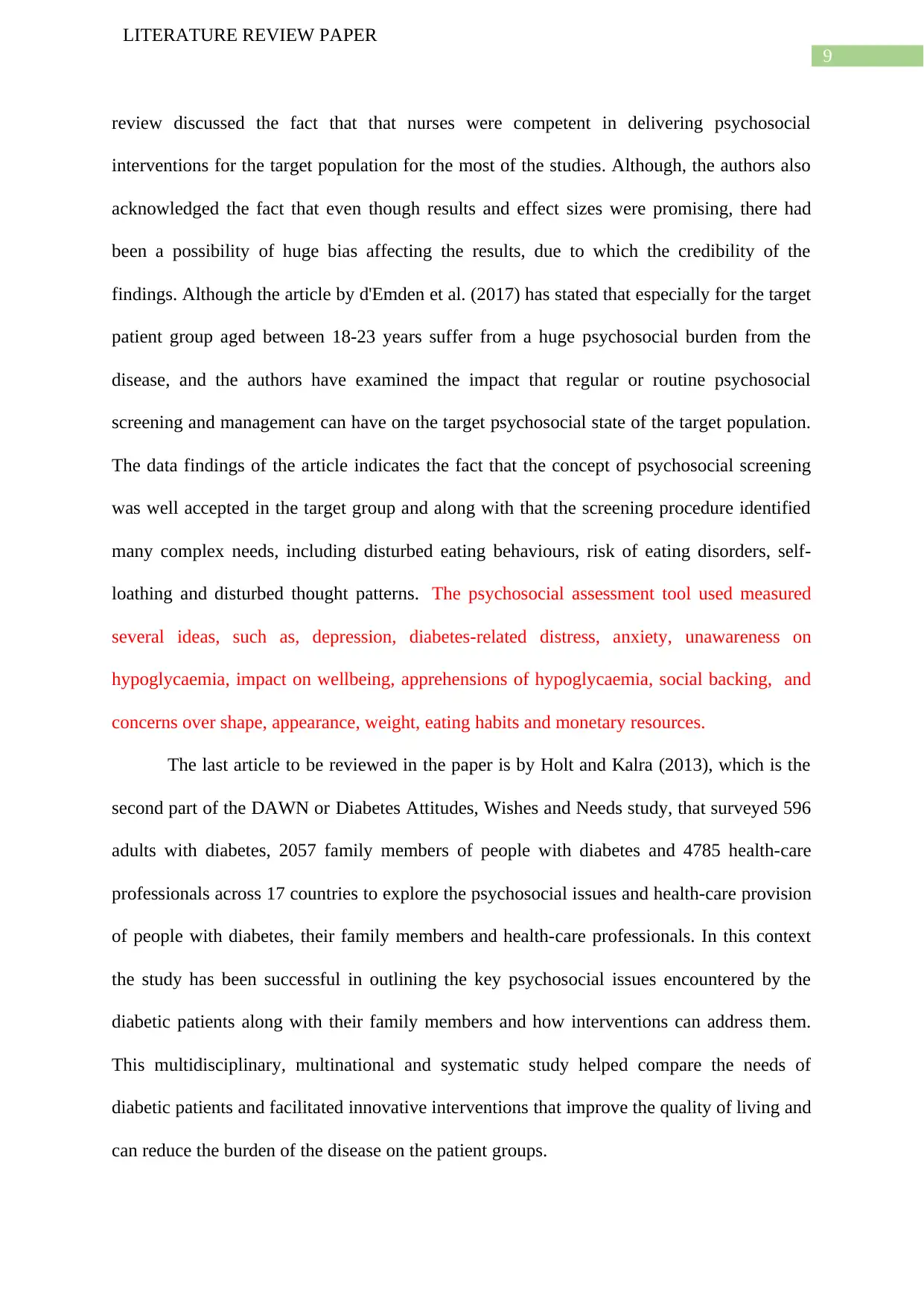
9
LITERATURE REVIEW PAPER
review discussed the fact that that nurses were competent in delivering psychosocial
interventions for the target population for the most of the studies. Although, the authors also
acknowledged the fact that even though results and effect sizes were promising, there had
been a possibility of huge bias affecting the results, due to which the credibility of the
findings. Although the article by d'Emden et al. (2017) has stated that especially for the target
patient group aged between 18-23 years suffer from a huge psychosocial burden from the
disease, and the authors have examined the impact that regular or routine psychosocial
screening and management can have on the target psychosocial state of the target population.
The data findings of the article indicates the fact that the concept of psychosocial screening
was well accepted in the target group and along with that the screening procedure identified
many complex needs, including disturbed eating behaviours, risk of eating disorders, self-
loathing and disturbed thought patterns. The psychosocial assessment tool used measured
several ideas, such as, depression, diabetes-related distress, anxiety, unawareness on
hypoglycaemia, impact on wellbeing, apprehensions of hypoglycaemia, social backing, and
concerns over shape, appearance, weight, eating habits and monetary resources.
The last article to be reviewed in the paper is by Holt and Kalra (2013), which is the
second part of the DAWN or Diabetes Attitudes, Wishes and Needs study, that surveyed 596
adults with diabetes, 2057 family members of people with diabetes and 4785 health-care
professionals across 17 countries to explore the psychosocial issues and health-care provision
of people with diabetes, their family members and health-care professionals. In this context
the study has been successful in outlining the key psychosocial issues encountered by the
diabetic patients along with their family members and how interventions can address them.
This multidisciplinary, multinational and systematic study helped compare the needs of
diabetic patients and facilitated innovative interventions that improve the quality of living and
can reduce the burden of the disease on the patient groups.
LITERATURE REVIEW PAPER
review discussed the fact that that nurses were competent in delivering psychosocial
interventions for the target population for the most of the studies. Although, the authors also
acknowledged the fact that even though results and effect sizes were promising, there had
been a possibility of huge bias affecting the results, due to which the credibility of the
findings. Although the article by d'Emden et al. (2017) has stated that especially for the target
patient group aged between 18-23 years suffer from a huge psychosocial burden from the
disease, and the authors have examined the impact that regular or routine psychosocial
screening and management can have on the target psychosocial state of the target population.
The data findings of the article indicates the fact that the concept of psychosocial screening
was well accepted in the target group and along with that the screening procedure identified
many complex needs, including disturbed eating behaviours, risk of eating disorders, self-
loathing and disturbed thought patterns. The psychosocial assessment tool used measured
several ideas, such as, depression, diabetes-related distress, anxiety, unawareness on
hypoglycaemia, impact on wellbeing, apprehensions of hypoglycaemia, social backing, and
concerns over shape, appearance, weight, eating habits and monetary resources.
The last article to be reviewed in the paper is by Holt and Kalra (2013), which is the
second part of the DAWN or Diabetes Attitudes, Wishes and Needs study, that surveyed 596
adults with diabetes, 2057 family members of people with diabetes and 4785 health-care
professionals across 17 countries to explore the psychosocial issues and health-care provision
of people with diabetes, their family members and health-care professionals. In this context
the study has been successful in outlining the key psychosocial issues encountered by the
diabetic patients along with their family members and how interventions can address them.
This multidisciplinary, multinational and systematic study helped compare the needs of
diabetic patients and facilitated innovative interventions that improve the quality of living and
can reduce the burden of the disease on the patient groups.
Paraphrase This Document
Need a fresh take? Get an instant paraphrase of this document with our AI Paraphraser
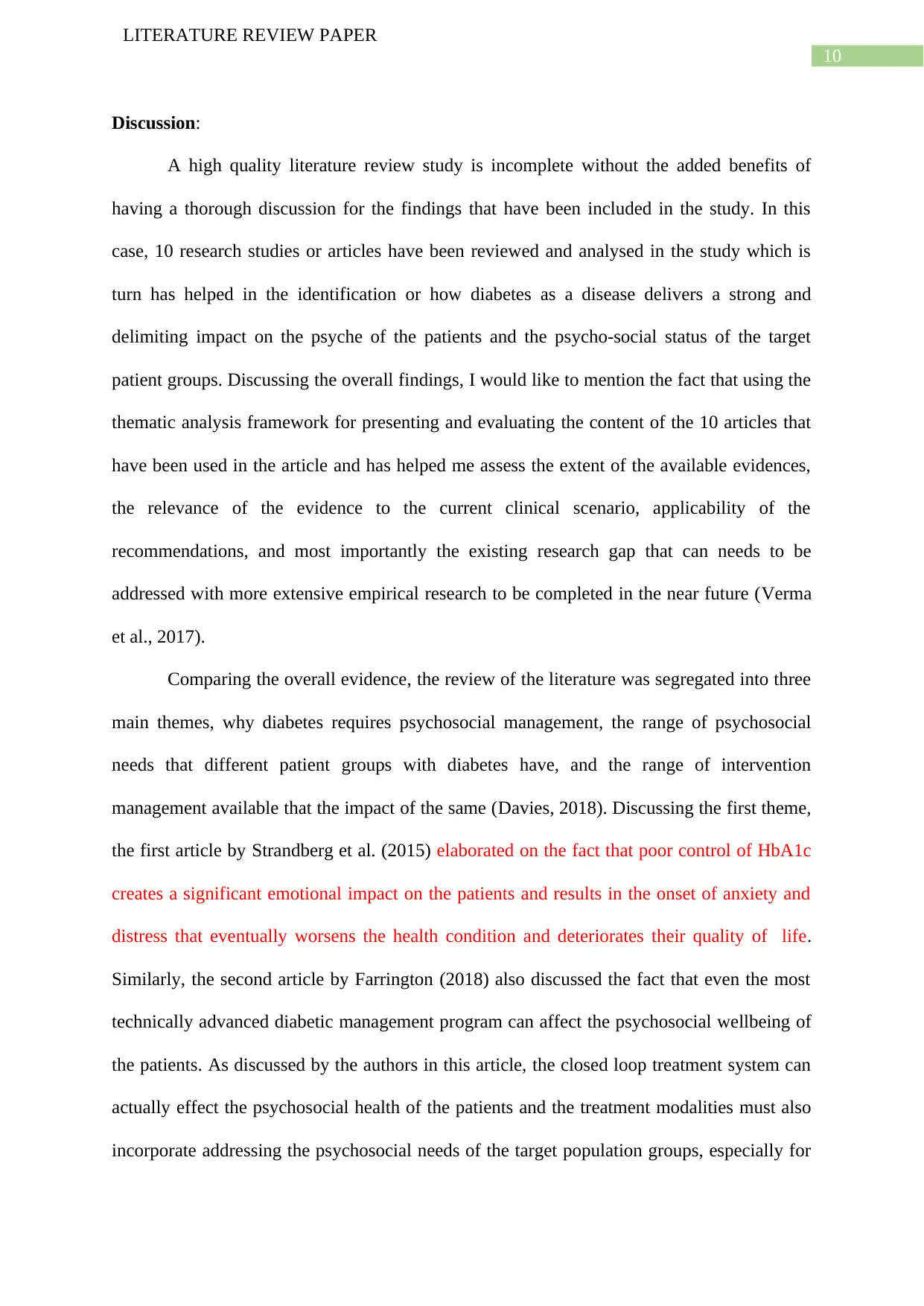
10
LITERATURE REVIEW PAPER
Discussion:
A high quality literature review study is incomplete without the added benefits of
having a thorough discussion for the findings that have been included in the study. In this
case, 10 research studies or articles have been reviewed and analysed in the study which is
turn has helped in the identification or how diabetes as a disease delivers a strong and
delimiting impact on the psyche of the patients and the psycho-social status of the target
patient groups. Discussing the overall findings, I would like to mention the fact that using the
thematic analysis framework for presenting and evaluating the content of the 10 articles that
have been used in the article and has helped me assess the extent of the available evidences,
the relevance of the evidence to the current clinical scenario, applicability of the
recommendations, and most importantly the existing research gap that can needs to be
addressed with more extensive empirical research to be completed in the near future (Verma
et al., 2017).
Comparing the overall evidence, the review of the literature was segregated into three
main themes, why diabetes requires psychosocial management, the range of psychosocial
needs that different patient groups with diabetes have, and the range of intervention
management available that the impact of the same (Davies, 2018). Discussing the first theme,
the first article by Strandberg et al. (2015) elaborated on the fact that poor control of HbA1c
creates a significant emotional impact on the patients and results in the onset of anxiety and
distress that eventually worsens the health condition and deteriorates their quality of life.
Similarly, the second article by Farrington (2018) also discussed the fact that even the most
technically advanced diabetic management program can affect the psychosocial wellbeing of
the patients. As discussed by the authors in this article, the closed loop treatment system can
actually effect the psychosocial health of the patients and the treatment modalities must also
incorporate addressing the psychosocial needs of the target population groups, especially for
LITERATURE REVIEW PAPER
Discussion:
A high quality literature review study is incomplete without the added benefits of
having a thorough discussion for the findings that have been included in the study. In this
case, 10 research studies or articles have been reviewed and analysed in the study which is
turn has helped in the identification or how diabetes as a disease delivers a strong and
delimiting impact on the psyche of the patients and the psycho-social status of the target
patient groups. Discussing the overall findings, I would like to mention the fact that using the
thematic analysis framework for presenting and evaluating the content of the 10 articles that
have been used in the article and has helped me assess the extent of the available evidences,
the relevance of the evidence to the current clinical scenario, applicability of the
recommendations, and most importantly the existing research gap that can needs to be
addressed with more extensive empirical research to be completed in the near future (Verma
et al., 2017).
Comparing the overall evidence, the review of the literature was segregated into three
main themes, why diabetes requires psychosocial management, the range of psychosocial
needs that different patient groups with diabetes have, and the range of intervention
management available that the impact of the same (Davies, 2018). Discussing the first theme,
the first article by Strandberg et al. (2015) elaborated on the fact that poor control of HbA1c
creates a significant emotional impact on the patients and results in the onset of anxiety and
distress that eventually worsens the health condition and deteriorates their quality of life.
Similarly, the second article by Farrington (2018) also discussed the fact that even the most
technically advanced diabetic management program can affect the psychosocial wellbeing of
the patients. As discussed by the authors in this article, the closed loop treatment system can
actually effect the psychosocial health of the patients and the treatment modalities must also
incorporate addressing the psychosocial needs of the target population groups, especially for
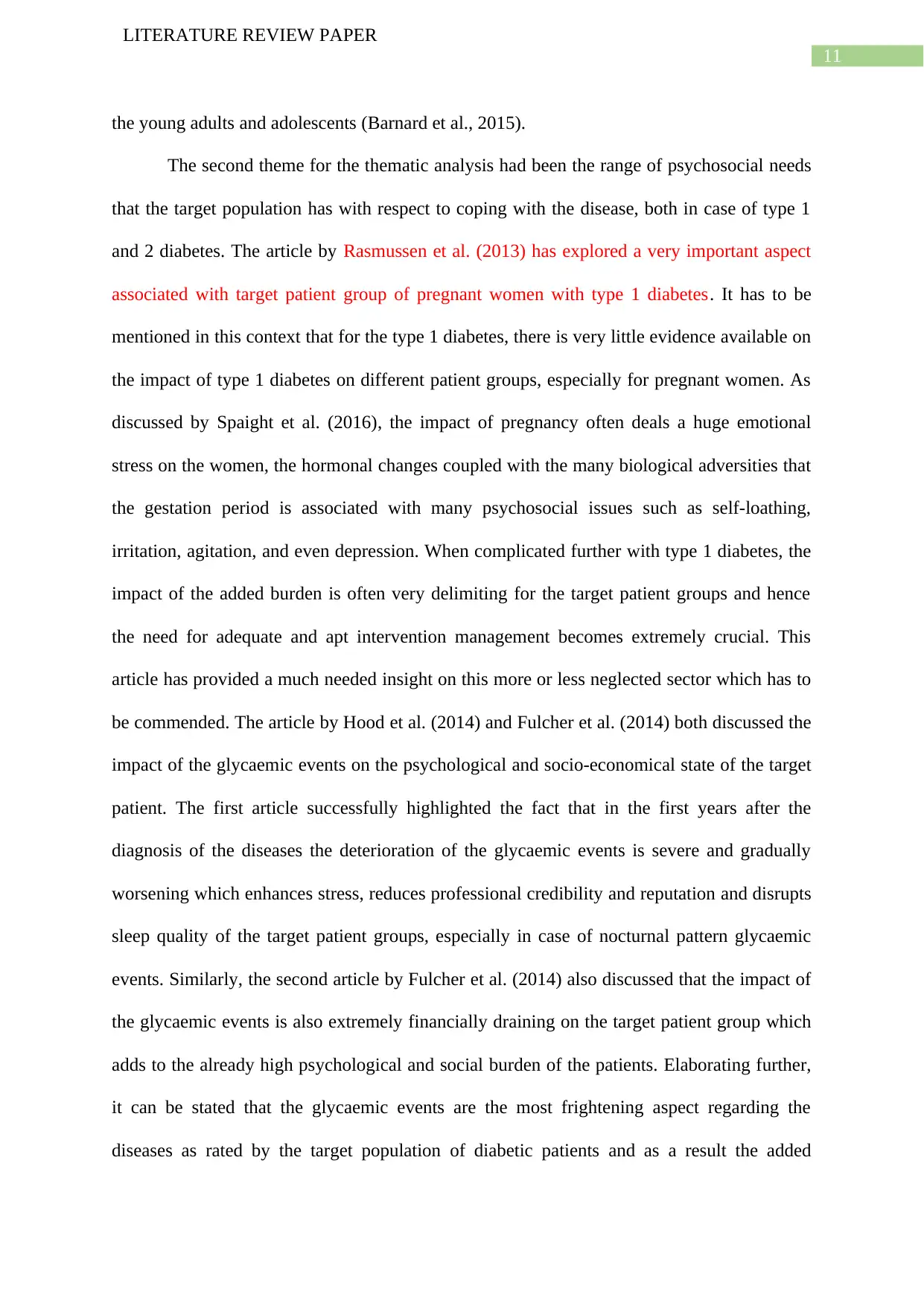
11
LITERATURE REVIEW PAPER
the young adults and adolescents (Barnard et al., 2015).
The second theme for the thematic analysis had been the range of psychosocial needs
that the target population has with respect to coping with the disease, both in case of type 1
and 2 diabetes. The article by Rasmussen et al. (2013) has explored a very important aspect
associated with target patient group of pregnant women with type 1 diabetes. It has to be
mentioned in this context that for the type 1 diabetes, there is very little evidence available on
the impact of type 1 diabetes on different patient groups, especially for pregnant women. As
discussed by Spaight et al. (2016), the impact of pregnancy often deals a huge emotional
stress on the women, the hormonal changes coupled with the many biological adversities that
the gestation period is associated with many psychosocial issues such as self-loathing,
irritation, agitation, and even depression. When complicated further with type 1 diabetes, the
impact of the added burden is often very delimiting for the target patient groups and hence
the need for adequate and apt intervention management becomes extremely crucial. This
article has provided a much needed insight on this more or less neglected sector which has to
be commended. The article by Hood et al. (2014) and Fulcher et al. (2014) both discussed the
impact of the glycaemic events on the psychological and socio-economical state of the target
patient. The first article successfully highlighted the fact that in the first years after the
diagnosis of the diseases the deterioration of the glycaemic events is severe and gradually
worsening which enhances stress, reduces professional credibility and reputation and disrupts
sleep quality of the target patient groups, especially in case of nocturnal pattern glycaemic
events. Similarly, the second article by Fulcher et al. (2014) also discussed that the impact of
the glycaemic events is also extremely financially draining on the target patient group which
adds to the already high psychological and social burden of the patients. Elaborating further,
it can be stated that the glycaemic events are the most frightening aspect regarding the
diseases as rated by the target population of diabetic patients and as a result the added
LITERATURE REVIEW PAPER
the young adults and adolescents (Barnard et al., 2015).
The second theme for the thematic analysis had been the range of psychosocial needs
that the target population has with respect to coping with the disease, both in case of type 1
and 2 diabetes. The article by Rasmussen et al. (2013) has explored a very important aspect
associated with target patient group of pregnant women with type 1 diabetes. It has to be
mentioned in this context that for the type 1 diabetes, there is very little evidence available on
the impact of type 1 diabetes on different patient groups, especially for pregnant women. As
discussed by Spaight et al. (2016), the impact of pregnancy often deals a huge emotional
stress on the women, the hormonal changes coupled with the many biological adversities that
the gestation period is associated with many psychosocial issues such as self-loathing,
irritation, agitation, and even depression. When complicated further with type 1 diabetes, the
impact of the added burden is often very delimiting for the target patient groups and hence
the need for adequate and apt intervention management becomes extremely crucial. This
article has provided a much needed insight on this more or less neglected sector which has to
be commended. The article by Hood et al. (2014) and Fulcher et al. (2014) both discussed the
impact of the glycaemic events on the psychological and socio-economical state of the target
patient. The first article successfully highlighted the fact that in the first years after the
diagnosis of the diseases the deterioration of the glycaemic events is severe and gradually
worsening which enhances stress, reduces professional credibility and reputation and disrupts
sleep quality of the target patient groups, especially in case of nocturnal pattern glycaemic
events. Similarly, the second article by Fulcher et al. (2014) also discussed that the impact of
the glycaemic events is also extremely financially draining on the target patient group which
adds to the already high psychological and social burden of the patients. Elaborating further,
it can be stated that the glycaemic events are the most frightening aspect regarding the
diseases as rated by the target population of diabetic patients and as a result the added
⊘ This is a preview!⊘
Do you want full access?
Subscribe today to unlock all pages.

Trusted by 1+ million students worldwide
1 out of 23
Related Documents
Your All-in-One AI-Powered Toolkit for Academic Success.
+13062052269
info@desklib.com
Available 24*7 on WhatsApp / Email
![[object Object]](/_next/static/media/star-bottom.7253800d.svg)
Unlock your academic potential
Copyright © 2020–2025 A2Z Services. All Rights Reserved. Developed and managed by ZUCOL.





